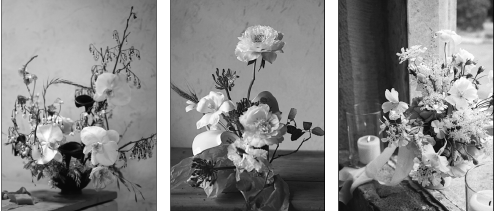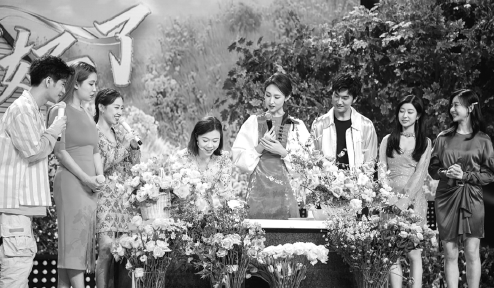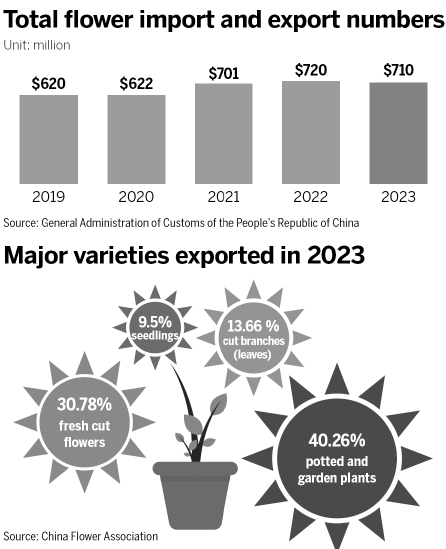A blooming success story
Flower sales blossom amid growing appreciation of their benefits and symbolism, Wang Qian and Li Yingqing report.

For Li Mengying, 32, a white collar worker in Guangzhou, Guangdong province, her flower balcony with vibrant blooms and green foliage provides her a soothing retreat from the outside world.
"It is my healing corner that provides the brief solace that keeps me from stress and anxiety after a tiring day," Li says, adding that flowers have the power to make her happy.
The beautiful blooms are her daily necessity, offering slivers of joy. Li is among the increasing number of flower enthusiasts in China who realize that horticulture has emotional benefits, such as stabilizing moods and increasing the sense of tranquility.
A recent report released by e-commerce platform Taobao in March echoes the trend, which says more than 1 billion users have bought plants and gardening tools on the platform, with 60 percent of them female.
It found buyers from Shanghai topped the regional consumer ranking of flower purchasing with more than 120,000 pots of plants delivered to more than 20,000 consumers in Shanghai every day on average.
The trend showed that buying a bouquet of flowers is no longer an occasional activity, but a huge market in China. According to statistics from the China Flower Association, the planting area for flowers in the country stands at nearly 1.6 million hectares.
Data from the Kunming International Flora Auction Trading Center, which is one of the country's largest such hubs, showed its total transactions last year exceeded 2.56 billion yuan ($353.6 million), up 20 percent year-on-year, with its volume reaching 2.34 billion units of fresh-cut flowers.
A country analysis of cut-flower exports by the International Association of Horticultural Producers finds that China is starting to be a major player in the international flower trade market, with exports valued at $125 million in 2020.
At the annual conference analyzing the country's floral industry held in Zhengzhou, Henan province, in March, Feng Huaibin, general manager of the Kunming center, said it is expected that the country's flower industry will continue to grow in the coming 10 years.
Wang Bo, deputy director of the sales department of Hua Jiang Pu, an enterprise providing flower-related services, under the leading manufacturer of chemical fertilizer Yunnan Yuntianhua Co, is optimistic about the market potential.
"In recent years, fresh flowers have hitched a ride on economic development, completing a transformation from being merely gifts to becoming daily goods. This change indicates that the floral industry will have even broader prospects for development," Wang says.
Flourishing art
The country's booming flower industry has offered tremendous potential for young entrepreneurs and florists with passion and innovation to build their career and business.
What's more, social media has facilitated the accessibility and visibility of flowers, allowing consumers to explore and purchase blooms, anytime and anywhere. The virtual realm has become a canvas for showcasing floral arrangements and sharing the beauty of flowers, further fueling their appeal among the younger generation.
Zhao Yun, a 36-year-old florist with nearly 2.2 million followers on short-video platform Douyin, has witnessed how Chinese consumers have undergone a remarkable shift in their attitudes toward flowers.
Before getting interested in flowers and opening her own flower store in 2017, Zhao used to work at a bank in Hunchun, Northeast China's Jilin province, which was a predictable life with stable income.
"It was a tedious job, which made me feel anxious, but all my unhappiness was healed by the bouquets of flowers sent by my husband, then my boyfriend," Zhao says.
"When seeing a flower, it 'tells' a story, conveying an emotion. The arrangement of different flowers, with different layers and colors, shows the silent dialogue between a florist and the flowers," Zhao says.
Although there were limited flower varieties available at the market, mainly roses, carnations, lilies and chrysanthemum, she found a soothing power in flower arrangement. Although neither of her parents agreed with her decision to quit the secure job, she started her own flower business and tried to let more people appreciate floral beauty. From selling a bouquet of flowers a week to being busy in the city, it took her half a year.
In 2020, when the COVID-19 pandemic was hitting the country, Zhao and her husband Chu Yunfeng moved to Kunming, Yunnan, to restart their business promoting floral culture and instructing how to start a floral business on social media.
As a knowledge-sharing ambassador for the platform, Zhao has been using Douyin to educate viewers about floral art. So far, she has posted more than 600 videos on Douyin, accumulating a total of 9.75 million likes. Zhao has also been invited by the State broadcaster China Central Television to demonstrate her floral design on television.
While promoting floral culture on social media, young florists, including 29-year-old Ding Yichen in Xuzhou, Jiangsu province, are exploring ways to create their own style with elements of Eastern aesthetics. Learning floristry in Seoul and London, Ding enjoys flower arrangement and opened her own brand — YCharn Studio.
"Guofeng (a kind of Chinese style using elements from traditional culture) is experiencing a resurgence in contemporary floral design. This year, I found increasing packaging designs featuring traditional Chinese patterns and motifs and some use xuanzhi, or rice paper, which reflects a growing interest in integrating traditional cultural elements into floral design," Ding says.
She adds from extravagant Western to Eastern minimalist displays, it still takes time for Chinese florists to explore their design vocabulary to craft unique contemporary works fusing Chinese traditional culture and philosophy.
E-commerce prospers
According to the global market data provider Statista, thanks to the country's booming e-commerce and fast-growing express delivery industry, China's online flower market is on the rise, with its total transaction value reaching approximately 127.91 billion yuan last year, an increase from about 20 billion yuan in the previous year. Its market size is expected to reach 164.4 billion yuan by 2025, data shows.
Flower-related enterprises, like the high-end flower brand Roseonly, flower subscription delivery company Reflower, traditional e-commerce platform Taobao and fresh food retailer Freshippo, have been riding the wave.
During International Women's Day on March 8, flower consumption experienced a peak in sales on fresh grocery delivery apps like Freshippo and Dingdong.
Dingdong estimates that the app's flower sales on March 8 increased by around 30 percent year-on-year. The company states that classic flowers, such as roses, tulips, and carnations, continue to be the mainstays for the Women's Day bouquets.
Priced at tens of yuan to hundreds of yuan, Dingdong and Freshippo have offered simple daily bouquets and elaborately packaged gift bouquets to meet various consumer demands.
To celebrate Mother's Day, which falls on May 12, Roseonly, the Beijing-based startup founded in 2013, promotes its special edition called The Pink, which consists of rose, carnations and hydrangeas, selling at 1,999 yuan.
With both the quantity and quality of the country's flower supply having been improved, the consumption patterns are changing, says Li Shenchong, director of the flower research institute at the Yunnan Academy of Agricultural Sciences.
For brands, this is a lucrative opportunity — but one beset by fierce competition.
Shanghai-based flower subscription delivery company Flowerplus paused operations due to lack of funds in September. In December, a statement released by the company said after negotiation and communication with suppliers and logistic partners, Flowerplus would recover delivery service as soon as possible.
Wang Ke, founder of Flowerplus, said in a livestreaming broadcast in December that, the nine-year-old company achieved profits in 2018, 2019 and 2020 and the core issue lies in the significant impact of the COVID-19 pandemic during 2021 and 2022, as well as the company's high operating costs.
He added that in the next step, the company would halve marketing and management costs, retaining only the WeChat miniprogram as the channel, and simplifying its production line.
"Household purchases to spice up routine life have now become the trend of flower consumption," says Fei Xuemei, vice-president of the China Flower Association's retail arm. With the development of the romance economy, consumer demand for high-quality flowers has been growing year by year, Fei adds.
According to the country's floriculture development plan (2022-35) released by the National Forestry and Grassland Administration and the Ministry of Agriculture and Rural Affairs, the country aims to realize the modernization of its flower industry by 2035, with the annual sales surpassing 700 billion yuan.




Today's Top News
- Xi sends congratulatory letter to forum dedicated to the International Year of Peace and Trust in Turkmenistan
- China to host 33rd APEC Economic Leaders' Meeting in Nov
- Strengthening domestic demand central to China's new five-year plan
- China's grain output tops 714 million tons in 2025
- China proposes theme, priorities for 2026 APEC 'China Year'
- Reforming consumption rules to fully unlock spending






























